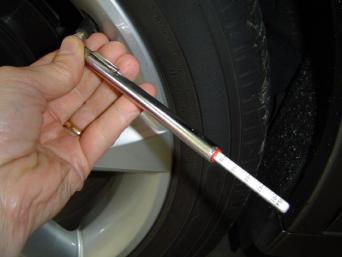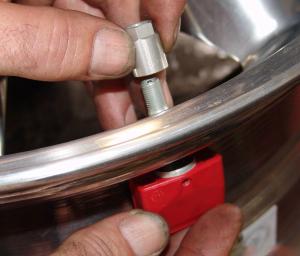
Home, Auto Repair Library, Auto Parts, Accessories, Tools, Manuals & Books, Car BLOG, Links, Index

Is your TPMS Warning Light On? The Tire Pressure Monitor System monitors the inflation pressure of the tires on your vehicle. If the pressure inside any tire drops 25 percent or more below its recommended inflation pressure, the warning light comes on to alert you.
Should you stop driving and check your tires immediately? It would probably be wise to find a safe place to stop or pull over so you can check the tires. You may just have a low tire that has been slowly seeping air over a period of time. Or, you may have a tire that is going flat. The TPMS Warning Light only tells you the pressure is low in one of the tires, not how fast the tire is losing pressure.
Important: Check the pressure in ALL of your tires, not just the one that triggered the TPMS Warning Light. Why? Because you may have other tires that are also low, but not low enough to trigger the warning light.
If you discover that one or more tires are low, add air to bring them back up to the recommended inflation pressure for your vehicle. You can find this information on a decal which may be mounted in a door pillar, the glovebox, or in your owners manual (which you should carry in your glove box).

TIP: You can't judge the amount of air you've put inside a tire by just looking at it. It may be underinflated or overinflated. Use an ACCURATE tire gauge to check the inflation pressure. The pressure gauges on service station air filling machines and air hoses are often way out of calibrationb (5 to 10 PSI or more!), so buy a small tire gauge and carry it in your glovebox.

NOTE: If you have been driving on the highway (especially during HOT weather), the air inside your tires will be hot and will read somewhat higher than when the tires are cold (which is when you are supposed to check air pressure). For more information about inflating your tires, and how to compensate for temperature changes, Click Here.
The arrival of cold weather causes the pressure inside your tires to drop - as much as 5 to 6 PSI depending on how cold it gets. If this causes the pressure inside your tires to drop below the threshold where the TPMS warning system is triggered (25 percent under the recommended inflation pressure), your TPMS warning light may come on.
To compensate for the cold weather, you may have to add a few extra pounds of air to each tire to bring it up to the point where the TPMS warning light will go off. Just remember that as you drive your car, the air inside the tires will warm up and increase in pressure so be careful not to overinflate your tires. Generally, tire inflation pressure will increase about 2 PSI after driving your vehicle 10 to 15 minutes, and as much as 5 to 6 PSI when the tires are hot (which requires driving at highway speed for 60 minutes or more).
Many motorists don't even know what the TPMS warning icon looks like (see the illustration at the top of this page). A recent survey found that many motorists could not identify the TPMS warning icon. For details, seeTPMS Survey: 42 Percent of Motorists Cannot Recognize TPMS Warning Icon
What happens if you ignore the TPMS Warning Light? Maybe nothing, or maybe something really bad. A low tire can be dangerous because it runs hot, especially if you are driving at highway speeds during hot weather with a fully loaded vehicle. If your tire suddenly blows out, it could cause you to lose control of your vehicle. Hundreds of fatalities have been blamed on blowouts that resulted in a vehicle rollover or crash! Don't take unnecessary chances. Check your tires, find the one that is low, and add air as needed to bring it back up to normal pressure.

TIP: Carry a 12-volt plug-in tire inflator in your truck for emergencies. These tools are easy to use, relatively inexpensive (under $40), and can come in real handy if you find yourself with a low or flat tire and no means of pumping it back up.
On some vehicles, you reset the TPMS Warning Light after you have inflated your tires by pressing a button or switch on the instrument panel. On other vehicles, the TPMS system will automatically reset itself and turn the TPMS Warning Light off after the vehicle has been driven a few miles after re-inflating the tires.
You have a problem. Assuming you found the low tire(s) on your vehicle and re-inflated them to the recommended pressure (using an accurate tire pressure gauge), and reset the TPMS system (unless it is supposed to reset automatically), a TPMS Warning Light that remains on means trouble.
You either have a bad pressure sensor in one of the wheels, or the TPMS system has self-diagnosed an internal fault that is prevent it from functioning normally.
TIP: The TPMS Warning Light have come back on because the tire you refilled is still leaking air. A small puncture will leak air and eventually allow the tire to get low or go flat again. Listen for any hissing sounds after re-inflating a low tire. If possible, spray some soapy water on the tire tread and look for bubbles that would indicate a leak. A tire can also leak air where the inner bead seals against the flange on the wheel rim. If the tire is leaking, it needs to be fixed.

TIP: Adding a can of aerosol or liquid sealer to a tire will often seal a small leak. BUT, make sure the product is APPROVED for use with TPMS-equipped vehicles. The sealer in some products may gunk up the sensor and prevent it from reading correctly.
If the tires on your vehicle have been replaced or serviced recently, the TPMS Warning Light may be the result of not putting the TPMS system through the proper learning/reset procedure. Each sensor sends out its own unique signal, and the TPMS system has to know which signal is coming from which sensor. The relearn procedure requires special tools, and must be done correctly otherwise the system may think a low tire pressure signal is coming from the Right Front (RF) sensor when in fact it is coming from one of the other three sensors on your vehicle.
Another possibility is that one of the tire pressure sensors was damaged when the tire was being dismounted or remounted on the wheel. TPMS tire pressure sensors are fragile and may be damaged if dropped on a concrete floor. The TPMS sensor housing may also be knocked loose from the valve stem if the tire bead is forced across it will dismounting or mounting a tire. This would be an issue to take up with the service manager at the store where you bought your new tires.

The TPMS warning light may remain on if one of the internal lithium-ion batteries that power each of the tire pressure sensors has gone dead. On most applications, the entire TPMS sensor must be replaced if the battery inside it has gone dead. These batteries are supposed to last 5 to 7 years. But the more you drive, the more often the sensors are active and using power. For this reason, most tire stores recommend replacing the TPMS sensors when you buy a new set of tires. Why? Because the TPMS sensors probably won't last until the next time you need tires. Better to replace them once when the tires are changed than to have to pay an extra labor charge later when a sensor fails.
If your vehicle as an INDIRECT TPMS system with no tire pressure sensors inside the wheels, a TPMS Warning Light that remains on may indicate a bad wheel speed sensor. This should also cause our ABS Warning Light to come on, as both systems use the inputs from the wheel speed sensors.
The TPMS Warning Light will also remain on if there is a fault in the TPMS control module, its power supply, or the antenna or module through which it communicates with the tire pressure sensors in each wheel. This type of fault will require a scan tool to diagnose.
 Related Articles:
Related Articles: Click Here to See More Carley Automotive Technical Articles
Click Here to See More Carley Automotive Technical Articles